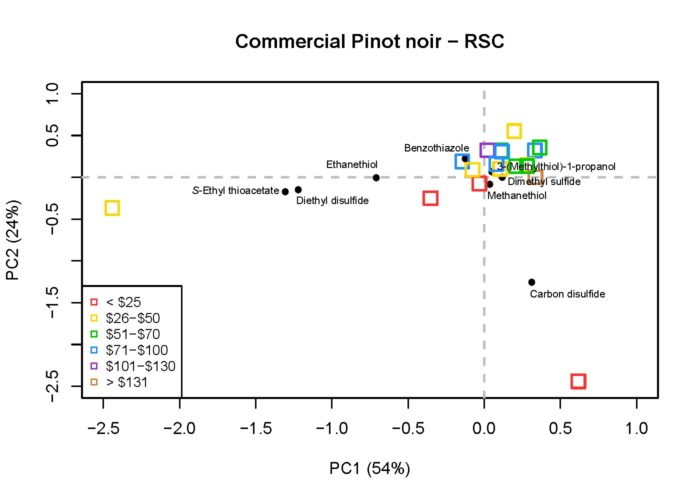Pinot Noir Aroma Chemistry
Shabnam Mosaferi, Dr Katie Parish-Virtue, A/Prof David Barker, A/Prof Bruno Fedrizzi
As the analytical exploration of wines intensifies, there is a need to further our ability to cover the “aroma” space (i.e. identify and ideally quantify the different species defining the wine aroma). This endeavour is somewhat limited by our intrinsic ability to recognise and quantify molecules. Chemists often rely on the chemical aroma that can be bought “off the shelf” while ignoring what’s not available.
The current literature presents a large number of aroma compounds that could have an impact on Pinot noir aroma, and R.A. 3.4 wants to challenge the way aroma chemistry has been carried out on New Zealand Pinot noir until now. In a way it proposes a paradigm shift where our group actually looks at the chemistry that has been untapped and aims at deciphering it by combining organic chemistry and analytical chemistry.
Organic synthesis of individual aroma compounds and their precursors can aid in this effort. The in-house production of novel aromas is married with analytical chemistry, allowing us to identify and quantify the presence and amount of compounds in Pinot noir wines that were not quantified before. This capability not only enhances our overall understanding of the chemical classes available in a wine, but also strengthens future yeast (fermentation) and plant (grapevine and viticulture) studies by adding new dimensions to their associated chemical analyses. Furthermore, the contribution of these practices is also beneficial to winemakers who can gain a greater appreciation and understanding for the complexity of the wines which they create.
As Pinot noir is a prominent variety on the New Zealand wine industry landscape, a range of terpenoids which are thought to contribute to the aroma profile of this wine are being investigated. The synthesis and analysis of these terpenoids and their precursors have the potential to act as biological markers for other research projects which focus around viticultural and winemaking impacts with regards to wine quality. To date, several free norisoprenoids have been successfully synthesised in our lab.
Concurrently, analytical methods involving either gas chromatography or liquid chromatography coupled with mass spectrometry are being developed. These separation techniques are being optimised for the detection and quantification of the synthetic molecules as they come into existence. Labelled analogues of these compounds are also being pursued synthetically for use in the methods. The methods considered are based on techniques easily transferrable to other labs involved in the Pinot noir Programme as well as other laboratories in New Zealand. The application of a simple pre-extraction based on solid phase extraction techniques ensures good sensitivity and reproducibility.
As well as the suspected contribution of these terpenoids to Pinot noir wine aroma, the presence of various sulfur compounds is also being investigated. Sulfur compounds have always had the stigma of being “stinky” molecules, with the exception of 3-mercaptohexanol and 3-mercaptohexyl acetate. Recent research shed some light on the broader contribution of other sulfur compounds (i.e. fermentative sulfur compounds) to the complexity and typicality of wine. In particular these molecules, which are produced during fermentation from natural amino acids, can enhance red fruity aroma and help characterise varieties and ageing processes.
The study of these molecules in wine will also allow to draw connections with the juice composition (in particular the amino acid pool in juice) and to an extension the grape composition itself. Our research group has already shown that specific amino acids found in grape juice are connected with the production of different sulfur compounds during fermentation. To gain an overview of the fermentative sulfur compound profile of Pinot noir, 18 commercially available wines from New Zealand were analysed using an in-house gas chromatography mass spectrometry method.
Results from this analysis can be viewed in Figure 1, with the wines being identified based on the indicated price brackets. As can be seen from the Principal Component Analysis (PCA) bi-plot, the majority of the wines analysed are centred close to the origin and form an overlapping mass of samples. This would suggest that these wines have similar profiles of the fermentative sulfur compounds analysed. Interestingly, there are two wines, which this PCA is able to clearly distinguish from the main cluster of samples. Although both of these wines come from the one of the two lower price brackets, it is important to note that other wines also in these price brackets are not as easily distinguishable from the main cluster of samples. This suggests that even within a single price bracket, there is a spectrum of fermentative sulfur wine profiles commercially available.

Figure 1: PCA biplot of fermentative sulfur compounds for 18 commercial Pinot noir wines coded by price range.
While this PCA displays some interesting findings, we are aware that the aroma profiling of these Pinot noirs is far more complex than just the fermentative sulfur compounds displayed here. Understanding this, the current project bridges the world of synthetic and analytical chemical workings in order to continuously improve upon the suite of compounds which we can detect and quantify in wine. At the completion of this project, aroma chemistry advances will allow us a greater range of analytical systems and procedures in order to further explore the multifaceted system which is Pinot noir wine.
This article first appeared in the October/November 2019 issue of New Zealand Winegrower magazine

















